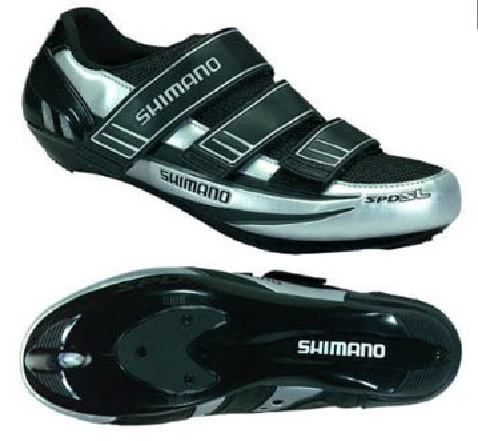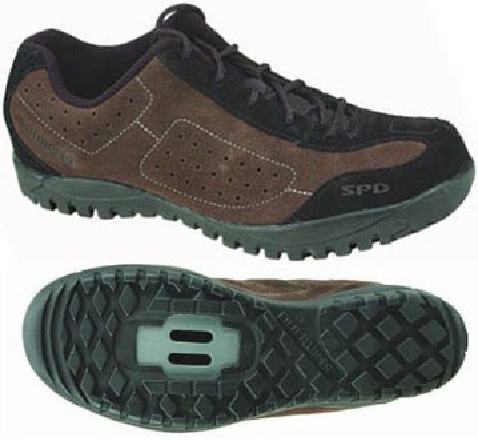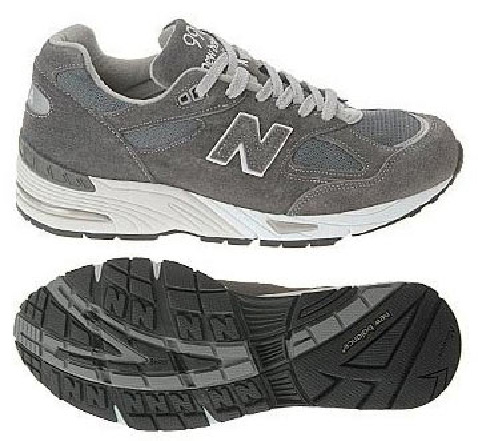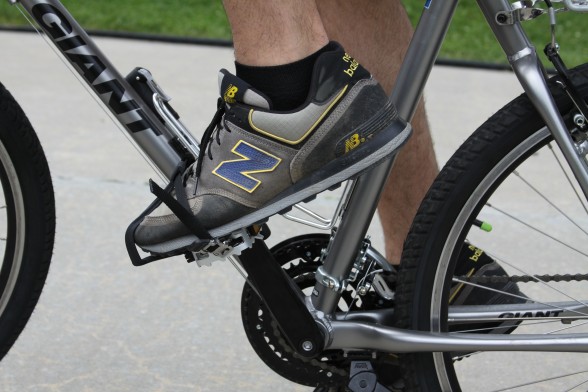Bicycle Touring Shoes
When you travel by bike, you’re going to be spending a lot of time in the saddle. But there comes a time at the end of each day when you will step off your bike and want to walk around. Which brings up the question, “What kind of shoes should you be using on your bicycle tour?”
Shoes are very important on a bicycle tour because they are the item that connects you with your bike. Select the right shoes and your ride will feel like a dream. But select the wrong shoes and your tour could quickly turn into a nightmare.
 Road Shoes
Road Shoes
To start, I want to show you the type of shoes that road riders typically wear. The reason I want to show you these shoes first is because they are great for long day rides, but horrible for long-distance self-supported touring.
In all my years, I’ve never seen a single person on a long distance bicycle tour wearing these types of shoes.
Road shoes are fine for long day rides or guided tours where your normal tennis shoes are carried for you in a vehicle that follows you along your route. In fact, if you have another pair of shoes to change into once you get off your bike, riding in these types of shoes might work just fine.
For the most part, however, road riding shoes are somewhat uncomfortable and they can be incredibly hard to walk in.
As you will see in a moment, there are better alternatives when it comes to shoes for traveling cyclists.
 Mountain Bike Shoes
Mountain Bike Shoes
The most common type of shoe I’ve seen in use by long distance bicycle tourists is the Mountain Bike Shoe. This type of cycling shoe uses a Shimano SPD clip to attach your shoes to your bike.
The reason these types of shoes are so popular for touring is that they allow you to connect with your bicycle for a powerful, enjoyable ride… but they also allow you to walk considerable distances in relative comfort. You probably wouldn’t want to walk for more than a couple miles in these types of shoes (I’ve done it), but covering a mile or two in MTB shoes won’t hurt you at all.
 Tennis/Running Shoes
Tennis/Running Shoes
Finally, you might consider riding in regular pair of tennis or running shoes. I rode with New Balance running shoes on my first two bicycle tours and they worked quite well. And just this past year I cycled through Europe, often times wearing a pair of $30 Nike running shoes. And again—no problem!
The disadvantage of riding with regular running/walking shoes is that they don’t provide you with the fluid, powerful ride that you get with shoes that clip to your bike. However, once you get off the bike, you’ll be completely comfortable covering long distances on foot. If you plan to do a lot of walking on your bike tour, riding in regular tennis shoes might be a good idea.
If you’ve been on a bicycle tour at some point in the past, what type of shoes did you bring with you (for riding your bike and for exploring on foot)?


I haven’t done a tour yet, but right now I use Power Grips straps and wear street shoes. Have you tried touring with these? I’m curious about your thoughts on these as an alternative to cycling shoes.
Thank you.
I think you are going to see more people traveling long distances on bikes using regular street shoes and toe clips or straps.
I, personally, am moving away from bike shoes and general bike clothing (for a number of reasons)…. and I think that on my next major trip I will likely just wear a pair of tennis shoes with a combination of straps or toe clips.
The reason I think we will see more people head in this direction is because the bicycle tourists of the past were largely concerned with spending hours and hours in the saddle, trying to push out as many miles as they possibly could. Traveling in this way, they wanted a shoe that would help them perform better on the bike. Getting off the bike and walking was secondary to their cycling.
But nowadays, I think more and more people are having just as many experiences off the bike as they are on it. And that means they want a shoe that works well off the bike… and on it.
Many people, myself included, now see the off-the-bike experiences as more important than the time on the bike… and so we want shoes that function well for walking, hiking, exploring, or whatever. And this is just part of the reason I think you will see more and more people moving toward bike travel with regular street shoes, straps, or toe clips.
In many ways, I think fewer people are seeing cycling as a sport… and are now viewing it as more of a lifestyle choice. So they are selecting shoes and clothes and gear that are more lifestyle driven.
I’ve made the mistake of taking road bike shoes for my first RAGBRAI, and it was horrible. LOOK cleats are the worst for walking. Way too much walking in and through towns. I could hardly want at the end – my ankles were killing me. I also killed one set of LOOK cleats (not cheap to replace from the rolling vendors).
The next RAGBRAI I used MTB shoes, and it was much better. Unless racing and max-efficiency is important, I found MTB shoes the way to go. I have Shimano MT31’s and they work well on the bike and look like hiking boots off the bike.
As it’s not a race, the MTB shoes work fine on and off the bike.
I did a few days of RAGBRAI three years ago, and I used sneakers for both on and off bike. Worked great.
I agree that mountain bike shoes are the best, but any cycling shoe can be better than plain sneakers. The first tour that I did was with a friend who wore tennies and I wore cycling shoes. The constant flexing of the sole caused his achilles tendon to swell up and it was so painfull that he had to quit the tour. Since then he now rides in cycling shoes and the problem has not come back in over ten years.
I’d used Power Grip straps before but though they allow user to pull up pedals (more efficient pedaling, with power transmission on upstroke and downstroke), the shoe makes a difference.
So I used Power Grips with cycling shoes – they don’t flex like sneakers (see Gerald’s comments above). Then I thought, since I’m using cycling shoes, why not cycling pedals as well.
I now use MTB shoes with road-shoe type clips when touring – this type of pedals are lighter ie have lower rotational mass.
Just finished a three week self supported tour in France. Lot’s of time off the bike. Used Sidi road shoes on the bike and switched to walking shoes when I got off to walk. Not a problem. Road shoes are fine for in and out of a cafe or small store. If you are going to be spending two hours walking through a cave or village, what’s the proplem with spending a few minutes switching shoes?
I used a leather-type pair of hiking boots that were padded and behaved almost like running shoes. Then the normal toe clips. Ankle support, and they worked great. I’m now having issues trying to find Shimano shoes in Toronto. It’s October, and inventories are low, not to mention the brilliant people at Shimano don’t list Canadian retailers. If push comes to shove, I’ll go back to the regular pedals and clips.
On my tour of Oregon and Idaho last summer there were quite a few people wearing Keen sandals. They make a model that accepts SPD cleats. Some people had the cleats and some didn’t. Some wore socks and some had interesting tan lines on their feet. I wore my mountain bike shoes and I was glad I did.
Paul
I’ve just started cycling after a 30 year spell, used to race in my younger days. I am trying to decide what shoe to use for touring. Afrer reading a few comments and asking around I think I’ll try my regular Salomon hiking shoes, they are more rigid than regular joggers, yet are very comfortable for long distance walking and are quite light.
As most of my rides are just for commuting or max distance fitness/fun rides of 25 miles I’ve been using power grips and a pair of hard soled “fashion” puma’s that never broke in. However a cycling friend suggested I try out spds for a multi-day tour I am doing. I have swapped my pedals for a set of shimano dual platforms, but I have had a helluva time finding reasonably priced women’s mtb shoes locally. I finally settled on a pair of bontrager mtb multi-sport shoes. A few weeks later, I came across the Specialized Riata, which I think would be a better shoe for me, but it’s too late to return the first pair : ( Nonetheless, I have consoled myself with the fact that should the clipless system work out for me, I can upgrade the shoes next year; and with two pairs of shoes, I’ll probably never need to buy another pair of cycling shoes ever again : ) And if I don’t like the SPDs, I can always go back to my beloved power grips : )
I should add that the multi-day tour is 75+ miles per day for 4 of 5 days, which was why I decided it might be time to go for something more sophisticated than the PGs. I don’t know if that will prove to be true, but I thought it was worth the experiment.
I enjoy touring with SPD-compatible sandals because they’re comfortable, don’t require socks, are comfortable for walking, and cool in the summer. No laces to get caught in the gears. On cooler days, I add socks. You can hose them off when dirty. Nice models by Shimano and Keen.
I bought a pair of the Keens last year and was anticipating good things. They say they are SPD compatible, but beware. I use Speedplay Frog pedals and cleats. They use the SPD mounting holes. The Keens are too narrow to accept them. I had to send them back. I was very disappointed not only that it didn’t work, but that Keen didn’t do their homework and design a better product.
I just completed a 10 day tour to Portland, Maine from upstate NY. This is the first tour on which I have ever used clipless, Shimano SPD, pedals and shoes. I have been back for two weeks and still don’t have complete feeling in my toes on both feet. As much as I like the efficiency and the “feel” of the shoe/peddle combination, I would hesitate using them again, or recommending their used for touring. I never had this problem with toe straps. Has anyone else had this problem? Is there a particular type of touring shoe that is designed to remedy this problem, or am I alone in this circumstance?
Tks: Bill
What specific type of shoe were you using? It sounds like the shoes you selected may have been too small for you… or you may have had the pedals or seat post in an ill-fitting position. It’s hard to say. I’ve never had my feet totally fall apart with SPD shoes, but I have had numbing in my hands due to the fact that my handlebars were too low and too far forward (a similar problem, perhaps?)
Shimano SPD, SH-MT22, size 48. They fit fine, feel great. Like I said, I have no reservations with the “feel” of the shoe/peddle combination, but the numbness still has not subsided, or maybe a little with the passage of time. It’s interesting to note, that when I do wear them to commute, the sensation of numbness is reduced while I am wearing them, but comes back after taking them off. Go figure. I still am weary of wearing them for any extended period, and at this point I will revert to regular pedals with straps. I will miss that locked in feeling though.
Thanks for your input. I appreciate your time.
Sincerely: WWR
I woud suggest the Keen Commuter bicycle sandles, I think Simano make some also. Great for warm weather and also don’t have to worry about the getting wet, because they dry in an instant.
I enjoy using my mountain biking shoes, they cushion the blows from the jumps and never seem to get too tight to wear.
Can’t wait till I get back into road riding again, some of the shoes they had in store were amazing!
#1 requirement for me is comfortable multiple use footwear, no matter how I travel.This rules out clipless for me. I have used Power Grips for many years. But the key to bike specific shoes is sole stiffness, which PG’s don’t address. Also it is important to have just the right combination of lug on the shoe sole and teeth on the pedal so one can get good power transfer throughout the crank revolution without inextricably trapping the foot during hasty dismount. SO, in Europe, I choose one of the fashionable but not-too-sporty styles that is made for walking. Like Mephisto, Clark, or certain styles of Keen. For riding I insert a custom heat-molded insole for ski boots that adds exactly the right amount of support, flex and cushion and it’s quite thin enough to fit most all my shoes comfortably.
My current favorites are a pair of Columbia ‘Mckenzie River Chukka’ boots. This is a highly modernized ankle boot in the style of the classic and famous Clark ‘Desert Chukka’ . They are made of thin oiled leather without padding or lining in the upper and, importantly, in a simple but sophisticated all black color. They have thin but cushioned soles, they’re very light, breathable, water resistant and are somewhat ankle supportive without restriction foot motion in the pedal. Tall enough to keep scree, bugs, rainwater and snow out. Good for all weather from sunny to icy with the appropriate sock choice (always high wool content of course).
I do not wear running shoes on tour because I know I’ll never have the energy to go for a run and there are better, less bulky choices for walking. Having lived in Europe for several years i would be extremely uncomfortable walking around in athletic footwear in most situations. I don’t like to be stared and laughed at in foreign countries. I am much more fashion conscious in Europe than America. The Chukkas are short enough to not look ridiculous with short pants. But then again short pants aren’t all that prevalent in Europe among the over-8-years-old crowd; even the kuhl Euro-hipsters generally limit themselves to nothing shorter than Capri’s in populated areas unless they’re playing football or skateboarding (in which case they go for nothing shorter than hip-hop skorts).
As for supplemental off-bike footwear I would probably go barefoot before I wore Crok’s outside of camp or a hostel. I understand these are just the thing for lounging around after a long hard day hiking the Appalachian trail but, if you go to Europe, please don’t do this to your country. Having tried many different styles of ‘house’ travel shoes I found myself going back to Teva style sandals. These can be worn sockless or with socks (quite acceptable in the summer in Europe), double as shower shoes (you DO wear shoes in public showers, don’t you?), and triple as water shoes at a beach or river. Yes you can bike short distances in them with the PG’s i.e. from hotel to the beach or market. I tend to modify them by replacing the nylon straps with Hypalon straps because I find the Hypalon less funky when I can’t dry them out well. I’m considering trying out some Teva Zilch minimalist sandals, or perhaps Vivo Barefoot Ultra shoes, as a space/weight reduced replacement for the Teva’s.
Just those two pairs of shoes take me comfortably anywhere in Europe, including to nice restaurants and concerts with a sport jacket.
Does no one remember the cycle touring shoes we had before ‘clipless’ became ubiquitous? They were thin but stiff soled, did not have much in the way of lugs on the bottom, so slid smoothly into toe-clips if you were using them. The stiffness prevented foot cramping. I have used mountain bike type clipless shoes, without the cleat, but the soles are very thick to accomodate the inset cleat. That means you have to raise your saddle for the same leg extention – a particularly bad idea when stopping and putting a foot down with a loaded touring bike. Most average cyclists don’t race or use clipless pedals. Why can’t we find stiff but thin soled cycling-specific footwear?
I hear you Paul. Those shoes must have been before my time. But I guess that’s the direction I’m going with the ‘Vivo Barefoot Ultra’s’. I recently got a pair and it seems they’ll work quite well.They are of the newer ‘barefoot running’ type shoe, but without the funky separate toes. That means the sole is extremely thin, but tough. Unfortunately it also means the sole is very flexible. I can ride with them but for only a few miles before it hurts. That means I must put in a very stiff insole. Those heat-moldable ski boot insoles work well.
These shoes come with two separable components. There is a very light EVA outer shoe and a neoprene inner shoe that ‘buttons’ into the outer. The inner slipper has a Kevlar sole. I can slip the stiff insole between the two. It is a very versatile set-up. I can use all three components together for long-distance biking. I can remove the stiff insole for walking or running with good warmth and protection. I can use just the outer as a post-ride camp shoe, or shower shoe. I can use just the inner as a slipper or sleeping shoe.
Brimstone: That’s very helpful, as was your previous comment. I hike, and occasionally cycle, with a fellow who is an inveterate walker, has walked the ‘pilgrim trails’ in both southern France and northern Spain. He has been educating me about ‘barefoot’ shoes.
I have looked on the web at the shoes you mention. But can you direct me to these ski boot insoles that stiffen up even a very flexible shoe for cycle touring?
Bike touring has gone from being a habit of some few to a lifestyle of many over the years. And the number will continue to spike as shoes as those on display here and other safety equiments start to populate the bike touring space. Been bike touring for 20 years, will be looking at purchasing some of these soon.